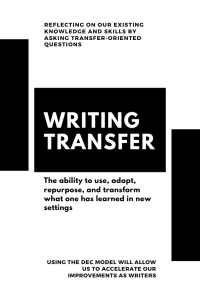By Communication Consultant Duy Nguyen (Accounting and BIS, ’22)
 As communication consultants at Rauch Center of Business Communication, we aim to provide meaningful assistance to fellow business students. We try to achieve this by using our understanding of the various difficulties our peers encounter during the writing process in general, or throughout a particular course’s procession. One of the devices that have proven beneficial not only during our consultations but also to students’ individual practice, is the use of writing transfer.
As communication consultants at Rauch Center of Business Communication, we aim to provide meaningful assistance to fellow business students. We try to achieve this by using our understanding of the various difficulties our peers encounter during the writing process in general, or throughout a particular course’s procession. One of the devices that have proven beneficial not only during our consultations but also to students’ individual practice, is the use of writing transfer.
Widely adopted across a number of disciplines including educational psychology, rhetoric, and composition, writing transfer is defined in many different ways. In the context of collegiate writing, writing transfer refers to the ability to use, adapt, repurpose, and transform what one has learned in new settings. Essentially, prior knowledge and skills are connected and serve to develop or supplement what we are currently working on. The concepts of transfer are not yet commonly known by people who don’t study writing instruction. Acquiring a better understanding of transfer would help us be aware of how we rely on similar skills across different writing tasks.
When previous experience and knowledge are brought to bear within a new context, writers can identify the areas in which they have high confidence. Not only could such information be reapplied in the new assignment, it could also help writers navigate unknown, yet similar, domains. On the other hand, we can also recognize where there is room for improvement when we lean on our prior learning to and work on inadequate sections in our documents.
As suggested by Madeline Crozier from the University of Tennessee Knoxville, there are two ways through which a writer could better facilitate the process of writing transfer.
One could start by asking transfer-oriented questions, which are expected to conjure up prior learning and lay the basis for further development of the project. Such questions include “Have I had experience with this type of assignment?” and “How did I approach my previous projects, and could I apply those approaches in this situation?”
Secondly, we can use the DEC model wherein writers follow three steps to integrate writing transfer into their work. We first detect, identifying connections between prior knowledge and the new situation. Among such connections, we elect one, choosing the most appropriate to apply to the current work. The final step is to connect, transferring the knowledge from the previous situation to the current writing task.
Reflecting on our existing knowledge and skills by asking transfer-oriented questions and using the DEC model will allow us to accelerate our improvements as writers. At the RCBC, we always get to know students first in order to build a foundation for making connections before jumping to work. Our communication consultants can help our peers to refine specific assignments and to leverage the power of writing transfer.
Get information and resources about our center at The Philip Rauch Center for Business Communication.
